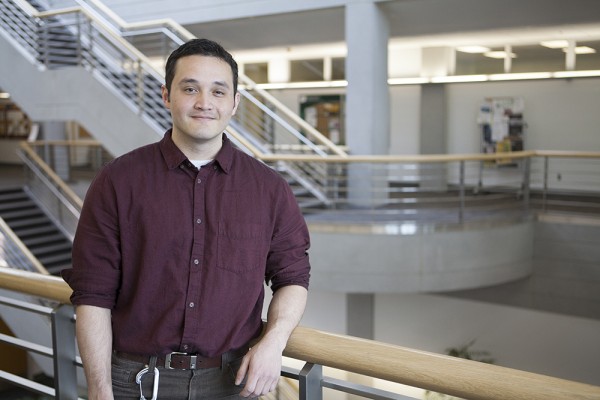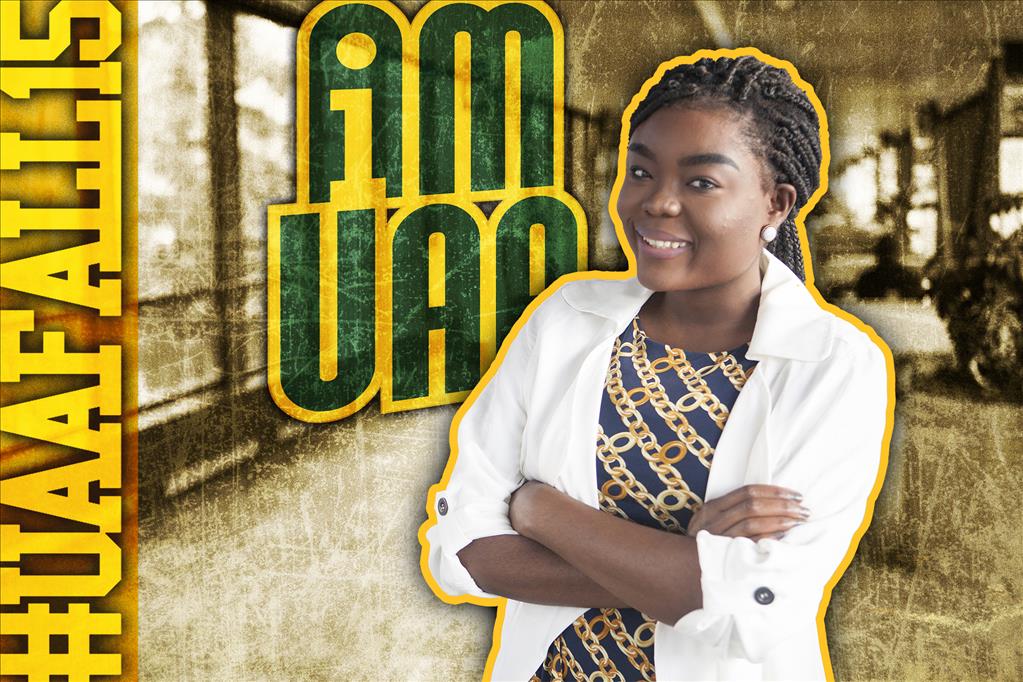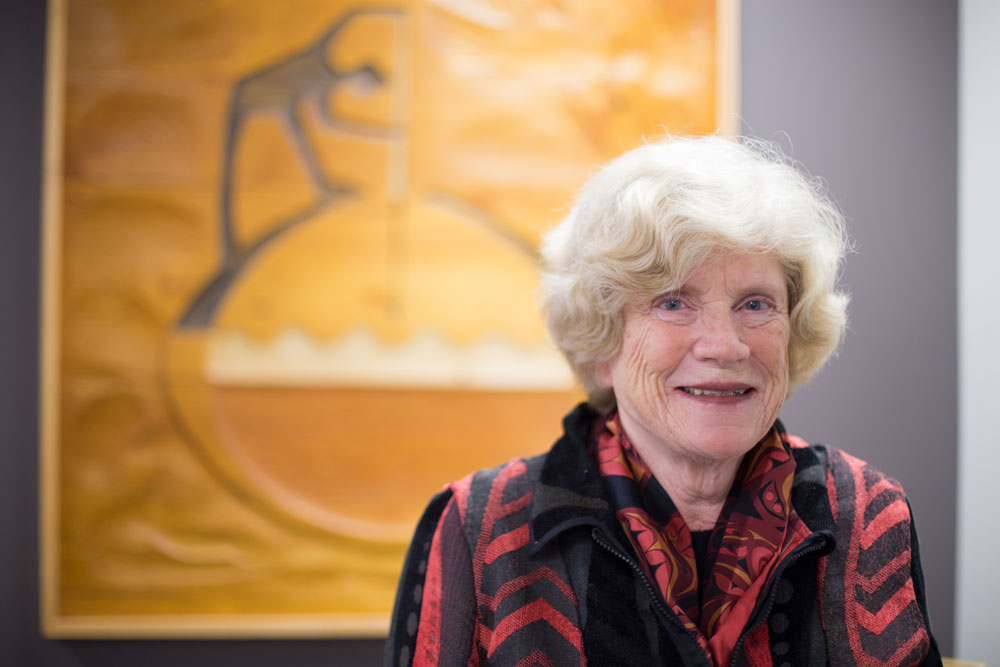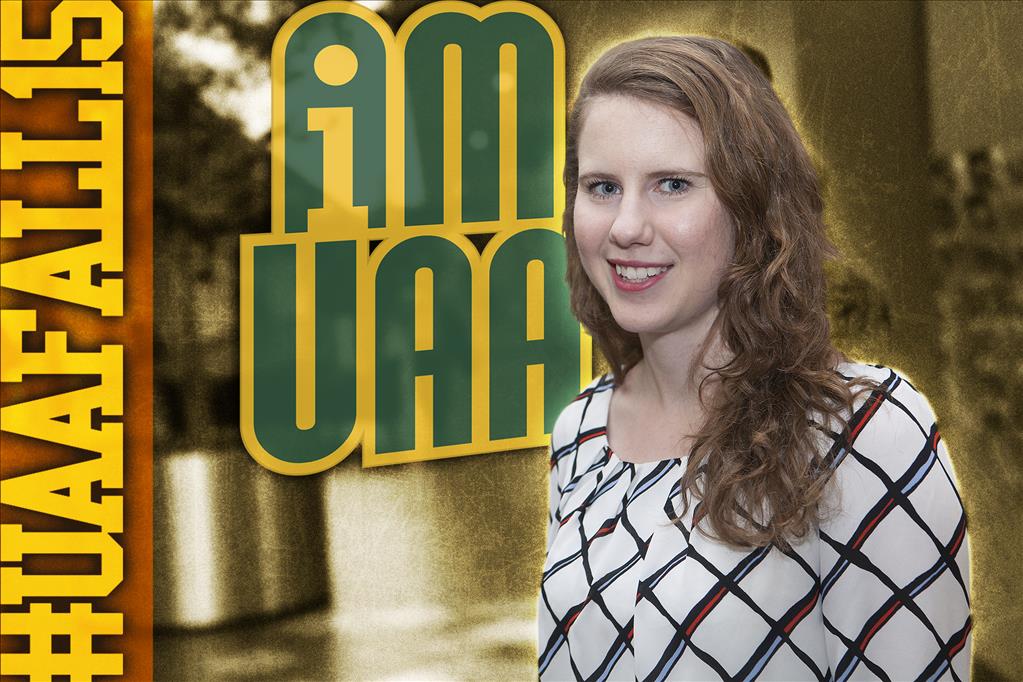'I was forced to rush between classes on foot'
by Tracy Kalytiak |
Kyle Ekstrand's first semester at UAA was tumultuous. He had moved up from California in the dead of winter, and, in a rush, signed up for classes.

Kyle Ekstrand, pictured, and one of his UAA Management Information Systems colleagues, Brian Smith, won an honorable mention for their MIS capstone project, UAA Maps, in March at the Association of Information Technology Professionals' National Collegiate Conference in Omaha, Neb. (Photo by Philip Hall/University of Alaska Anchorage)
"I had the inappropriate feeling of good fortune when I scheduled my classes, as they were back to back on the schedule," said Ekstrand, 26, a UAA Management Information Systems student.
Ekstrand didn't realize until too late that he had scheduled courses situated at opposite ends of UAA's campus, giving him 15 minutes to move between the Fine Arts Building on east campus to Beatrice McDonald Hall on west campus-a distance of more than a mile.
"I was forced to rush between classes by foot," Ekstrand said. "I was unable to ever make my second course in BMH on time, ever, and it affected my grade. The largest hassle was the constant interruption I'd cause by showing up late, flushed and breathless."
Clearing away clutter
Ekstrand remembered that long-ago predicament when he and fellow MIS student Brian Smith, 29, started creating UAA Maps, their MIS capstone project. Smith worked as primary developer; Ekstrand played the role of project manager and backup developer; Eric Pedersen, vice chancellor of enrollment services, sponsored the UAA Maps project, which received an honorable mention at the Association of Information Technology Professionals' National Collegiate Conference, held in March in Omaha, Neb.
UAA Maps is located at at http://www.uaa.alaska.edu/maps. With a student ID, a student can log in and UAA Maps will show on a map that person's class schedule and the location of his or her courses. It's also possible to get directions, which, thanks to the students' work with Google, includes traveling through Spine 1, Spine 2, or Spine 3, as needed. The general public may use other parts of the maps app.
"The UAA printed map is...cluttered, to say the least," Ekstrand said. "You can see the map at https://www.uaa.alaska.edu/map/upload/uaa-campus-map.pdf. It's densely populated with various symbols and multiple locations."
The present map only gives directions to the main UAA campus, not to the satellite campuses outside Anchorage. UAA Maps, Ekstrand said, can add new GPS coordinates in the future with little or no effort, and dynamically update the maps page as more coordinates are added to its database.
"This system could potentially be rolled out to other UA campuses with very little effort if it turns out to be useful," he said.
The impending rollout of UAA's new content management system-a computer application that allows easy publishing and editing of content on UAA's website-will spruce up the way UAA Maps looks on a smartphone, said Dr. Dennis Drinka, associate professor in UAA's Department of Computer Information Systems.
"One of the larger complaints we had was that the map system is not mobile-friendly," Ekstrand said.
The constraints of UAA's present CMS hampered Smith and Ekstrand's efforts to create a site people could access and use with their smartphones. The new CMS, however, will remove barriers to smartphone use of UAA Maps.
Thriving and succeeding
Ekstrand first learned about MIS when he told an adviser he was interested in computers and had already met some business requirements for a B.B.A.
"The MIS program is a small sliver of the enrolled students at UAA," Ekstrand said. "I soon came to love it. The combination of astonishingly dedicated professors and motivated and intelligent peers pushes the MIS students to thrive and succeed in the face of challenge. I honestly have never belonged to such a strong cohort, nor been involved with such enthusiastic and caring professors-and I have been in seven different majors across four schools. We are encouraged to choose a specialty, and teach ourselves as much as we can and act independently, and this has been critical to my growth as a professional and as an adult."
Ekstrand became interested in creating UAA Maps for two reasons.
"I understood the previous UAA maps were difficult to read and navigate, and had experience with trying to properly coordinate my classes and schedule," he said. "Second, the challenge of creating a novel system like this was enticing; with a bit of research, we discovered that no other university campus had implemented a solution like this to plot buildings on Google Maps-or at least our searches didn't find any. Additionally, we understood this project would be complex due to the numerous systems and subsystems we would have to interact with in the UA system, which was attractive as well."

UAA Maps, developed by Management Information Services students Brian Smith and Kyle Ekstrand, will help students better plan their commutes between classes.
As Ekstrand knew through his own experience, students can have difficulties navigating through campus and, because of this, might schedule their courses poorly.
"A 'perfect' schedule in some students' eyes is one in which they go from one class to the next and are able to efficiently allocate their time through consolidation of their schedule," Ekstrand said.
But, as Ekstrand knew from experience, occasionally students will schedule courses separated by distances of greater than a mile without realizing it.
"Our goal was to remedy these two issues by presenting course information and distances in an understandable and easy-to-access, intuitive format."
Learning outside a classroom
Smith and Ekstrand spent most of their time working from home, conversing via Slack and other communication tools.
"Almost zero percent of our time was spent working from a classroom," Ekstrand said. "We met at various coffeeshops and WiFi-enabled restaurants for meetings-and a bar with WiFi, one time," Ekstrand said. "And due to the technical nature of the project, we were able to work from virtually wherever we wanted. For meetings with various UAA parties, we met on campus at multiple locations to ensure we could have face-to-face communication. As for plotting map locations, we were able to plot the locations at UAA using Google Maps to pinpoint the locations."
Various UAA departments helped Ekstrand and Smith decide the approach they would take to create the foundation for UAA Maps.
"Our sponsor, in addition to the UAA IT team and the Facilities Planning and Construction team, assisted us in creating a worthwhile and thoroughly vetted system," Ekstrand said. "We made use of their input by ensuring every party involved in the system was constantly communicated with, and that they understood what we needed, why we needed it, and how they could help."
Removing roadblocks
Pedersen smoothed the path for the work Smith and Ekstrand were doing.
"I would have to ask, 'What roles didn't Eric play in removing barriers?'" Ekstrand said. "Whenever we ran into roadblocks, I would work with Eric, his team-especially Mayra López-González, director of Student Electronic Services, and UAA Registrar Lora Volden-and others, to overcome barriers and find the optimal solution to our problems. Additionally, UAA IT-primarily Adam Paulick, Brandon Wood and Ryan Adkins-were always willing to advise us in the best path forward for working with the UAA IT systems."
The site will receive a facelift from UAA IT in the near future when UAA migrates to a new CMS.
"So expect changes!" he said.
What goals does Ekstrand hope to achieve with his education in MIS?
"Anything and everything, I think would be an ambiguous yet fitting answer," he said. "We are given the opportunity to face daunting challenges, and are forced to learn how to teach ourselves whatever is necessary to get a task done, be it for pleasure or work. I imagine I am going to have a fulfilling career-I was offered numerous positions as a result of the program-and accepted a position at USAA (United States Automobile Association) in San Antonio, Texas, as an application developer. My hope is to simply put what I've learned to use, both the soft skills and the technical bits, and enjoy myself while doing it."
Written by Tracy Kalytiak, UAA Office of University Advancement
 "'I was forced to rush between classes on foot'" is licensed under a Creative Commons Attribution-NonCommercial 4.0 International License.
"'I was forced to rush between classes on foot'" is licensed under a Creative Commons Attribution-NonCommercial 4.0 International License.














